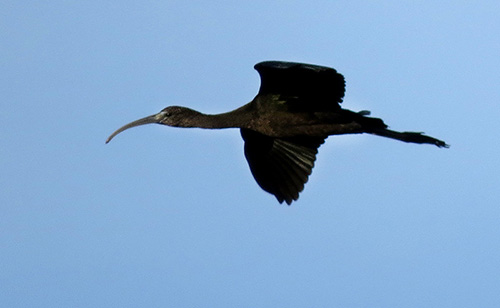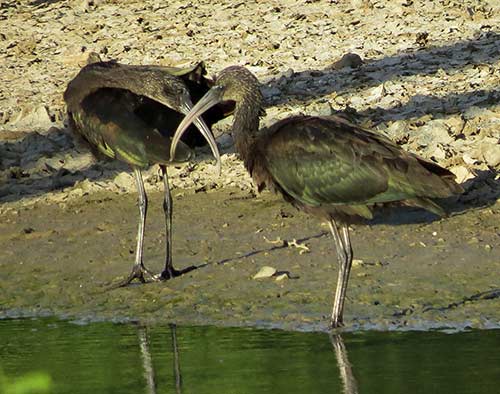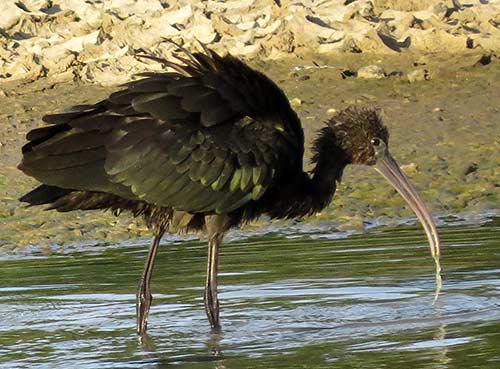Glossy Ibis Observed on Bonaire
Six Glossy Ibises were observed on September 27, 2020
Posted September 30, 2020
Fall migration brings many rare birds to Bonaire.
Last week, fall officially opened with the autumn equinox, and it appears that Bonaire’s migrating birds have been following the calendar as well, as many rare birds are arriving on our shores. This past Sunday, I was delighted to observe a grouping of six Glossy Ibises, the largest grouping ever recorded on Bonaire.
About the Glossy Ibis.
The Glossy Ibis (Plegadis falcinellus) is a wading bird in the ibis family Threskiornithidae. The scientific name comes from the Ancient Greek plegados and Latin, falcis, both meaning “sickle” and referring to the distinctive shape of the bill. In fact, it was this very same sickle-shaped bill that caught my attention.
Six Glossy Ibises were observed together forming one grouping.
I was out birding on Sunday late in the afternoon, and as I drove by a small pond toward the eastern side of the island, I saw five large blackish birds out of the corner of my eye. I immediately stopped and turned around to investigate, but two cyclists rode by at the same time, and the five birds took flight. As they soared over my head, I saw the distinctive sickle-shaped bill and knew they were ibises….but which one? I was just sad that I hadn’t had an opportunity to photograph them before they took flight.
But as I stopped the car, I saw that one bird remained! So there were six! I immediately identified it as a Glossy Ibis, a rare visitor to Bonaire. As I started photographing the bird, it remained relatively close.
But my luck held, and the five ibises which first flew away soon returned, and I was able to observe all six from just a few meters away. Having seen their reaction to the cyclists, I decided to stay in the vehicle and shoot from within, as the birds didn’t seem to mind the car, but did seem to mind people. I often use this same technique for flamingos as well, which appear skittish when people are too close for comfort.
What makes the Glossy Ibis a rare bird for Bonaire?
The Glossy Ibis is actually the most widespread of ibis species, breeding in the warmer regions of Europe, Asia, Africa, Australia, and the Atlantic and Caribbean regions of North America. Although they are not breeding here on Bonaire, we do only occasionally have sightings. The Glossy Ibis is highly nomadic and can disperse widely after its nesting season.
Prior recorded sightings of the Glossy Ibis on Bonaire.
In checking prior recorded sightings of the Glossy Ibis on both eBird and Observation, the oldest record was from September 29, 1980, nearly 40 years to the day from this year’s sighting!
Since 1980, there appear to be several sightings of individual birds here and there, but only one sighting recorded with two birds, that one where two individuals were observed in a mixed grouping with Black-bellied Whistling Ducks on October 24, 2015.
This year’s sighting is the largest grouping ever officially recorded on Bonaire.
However, as with many nomadic birds, one must get to their locations fast to observe them…….a visit back to the same area on Tuesday found them gone. Perhaps they have relocated to another spot on Bonaire, or perhaps they have moved on. Time will tell if we see them again.

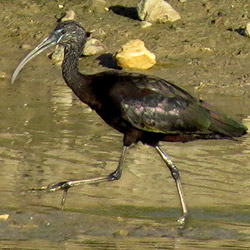
Glossy Ibis
(Plegadis falcinellus)
Diet: Insects, mollusks, crustaceans, and occasionally fish, amphibians, lizards, small snakes, or nestling birds
Breeding: Lays 3 to 4 eggs
Status: Least Concern
About the author
Susan has been living on Bonaire for over 30 years. She is a certified bird guide, a PADI SCUBA Diving Master Instructor, and an underwater and topside photographer.
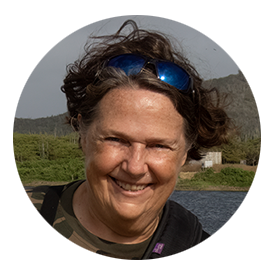
Reach out to Susan
Contact Susan via email, Facebook Messenger, give Susan a call, or simply use the online form below.
If you have any questions in regard to your birding tour on Bonaire, feel free to contact Susan to get answers. She is always happy to elaborate on routes or best times for a tour based upon your own personal preferences. Tours can be tailored to your own interests, whether that be birds, photography, or both!
It is also recommended that you do some homework about Bonaire's birds before you visit. By knowing a little bit about the birds which might be encountered on tour, your enjoyment will be heightened! Be sure to check out these resources for Bonaire Birding. Reading the Bonaire Bird Blog will also accustom you to the birds that habitually are encountered on Bonaire.
Facebook Messenger
Get in touch via Facebook Messenger
Telephone
Get In Touch
Get in touch with Susan to check availability for the dates you are visiting Bonaire.
Consent: By using this form you agree with the storage and handling of your data by this website.




